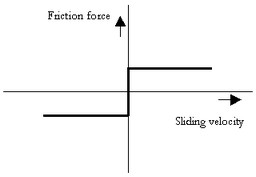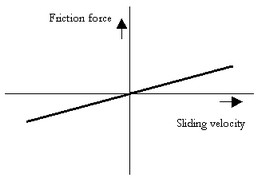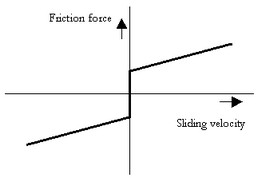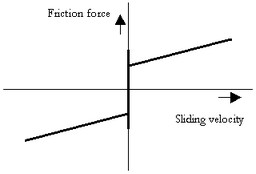Iconic Diagrams\Mechanical\Rotation\Components
C
V
CV
SCVS
LuGre
Domains: Continuous. Size: 1-D. Kind: Iconic Diagrams (Rotation).
The friction model represent bearing friction with various friction models. The model have only one initial port p defined. Because any number of connections can be made, successive ports are named p1, p2, p3 etc. 20-sim will automatically create equations such that the resulting force p.F is equal to the sum of the forces of all connected ports p1 .. pn. The velocities of all connected ports are equal to p.v.
p.F = sum(p1.F, p2.F, ....)
p.v = p1.v = p2.v = ....
This model represents a bearing with friction torque described as coulomb friction:
p.T = Tc*tanh(slope*p.omega);
Tc: the coulomb friction
slope: the steepness of the coulomb friction curve.

Ports |
Description |
p[any] |
Any number of connections can be made (Rotation). |
Causality |
|
Fixed torque out |
|
Parameters |
|
Tc slope |
Coulomb friction [N.m] Steepness of Coulomb friction curve [s/rad] |
This model represents a bearing with friction force described as viscous friction:
p.T = d*p.omega;
d: the viscous damping

Ports |
Description |
p[any] |
Any number of connections can be made (Rotation). |
Causality |
|
Fixed torque out |
|
Input |
|
Fn |
Normal force [N] |
Parameters |
|
d |
Viscous friction torque or damping [N.m.s/rad] |
This model represents a bearing with friction force described as coulomb plus viscous friction:
p.T = Tc*tanh(slope*p.omega) + d*p.omega;
d: the viscous damping
Tc: the coulomb friction
slope: the steepness of the coulomb friction curve.

Ports |
Description |
p[any] |
Any number of connections can be made (Rotation). |
Causality |
|
Fixed torque out |
|
Input |
|
Fn |
Normal force [N] |
Parameters |
|
mu_v Tc slope |
Viscous damping [N.m.s/rad] Coulomb friction [N.m] Steepness of Coulomb friction curve [s/rad] |
This model represents a bearing with friction force described as static plus coulomb plus viscous plus Stribeck friction:
p.T = (( Tc + (Tst*abs(tanh( slope*p.omega )) - Tc)
* exp( -((p.omega / v_st)^2 )) ) * sign(p.omega)
+ d * p.omega);
Tst: the static friction
d: the viscous damping
Tc: the coulomb friction
slope: the steepness of the coulomb and static friction curve.
v_st: the characteristic Stribeck velocity.

Ports |
Description |
p[any] |
Any number of connections can be made (Rotation). |
Causality |
|
Fixed torque out |
|
Input |
|
Fn |
Normal force [N] |
Parameters |
|
Tst d Tc slope v_st |
Static friction torque [N.m] Viscous friction torque or damping [N.m.s/rad] Coulomb friction [N.m] Steepness of Coulomb friction curve [s/rad] Characteristic Stribeck velocity [rad/s] |
This model represents a bearing with friction force described by the LuGre friction model:
p.T = f_lg(p.omega);
f_lg: the LuGre friction model
Ports |
Description |
p[any] |
Any number of connections can be made (Rotation). |
Causality |
|
Fixed torque out |
|
Input |
|
Fn |
Normal force [N] |
Parameters |
|
Tc Tst d v_st c |
Coulomb friction [N.m] Static friction torque [m] Viscous damping [N.m.s/rad] Characteristic Stribeck velocity [rad/s] Stiffness at zero speed [N.m/rad] |